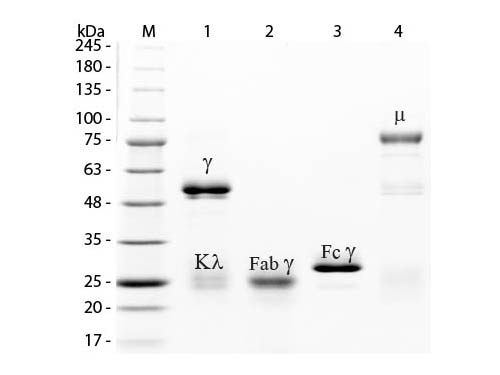Tips for Antibody Purification Using Immobilized Protein A & G
The basis for the purification of IgG, IgG fragments, and IgG subclasses is the high affinity of protein A and protein G for the Fc region of polyclonal and monoclonal IgG-type antibodies. Protein A and protein G are bacterial proteins, which, when coupled to chromatography matrices such as Agarose or Sepharose, generate exceptionally useful, easy-to-use media (resin) for many routine applications. Protein A/G is a recombinant of Protein A and Protein G that has the additive binding properties of both proteins. Protein A, protein G, and protein A/G can be used for the purification of monoclonal IgG-type antibodies, purification of polyclonal IgG subclasses, and the adsorption and purification of immune complexes involving IgG. IgG subclasses can be isolated from cell culture supernatants and serum and ascites fluid.

-
Binding Strength
- The binding strength of protein A and protein G for IgG depends on the source species and subclass of the immunoglobulin. The dynamic binding capacity depends on the binding strength and on factors such as flow rate during sample application. Binding strengths should be tested with free protein A or protein G and can be used as a guide to predict the binding behavior to a protein A or protein G purification resin.
- Protein G Sepharose is a better choice for overall capture of antibodies. Protein G binds more strongly to several polyclonal IgG’s as well as to human IgG3. Under standard buffer conditions, protein G binds to all human and all mouse IgG subclasses. Protein G also binds to rat IgG2a and IgG2b.
- Binding of the target protein may be made more effective by adjusting the sample to the pH and composition of the binding buffer (dilute the sample in binding buffer or perform a buffer exchange using a desalting column).
-
Sample Preparation and Application
- Samples should be clear and free from particulate material. Simple steps to clear up a sample before purification will prevent clogging the column, decrease the need for stringent washing and will extend the life of the chromatography resin.
- The column should be pre-equilibrated in binding buffer before sample application.
- Test for a flow rate that provides the most efficient binding during sample application since this parameter can vary according to the specific interaction between the target protein and the ligand as well as their concentrations.
- For strong affinity interactions between the ligand and the target molecule, sample can be applied at a high flow rate. For interactions with weak affinity and/or slow equilibrium, a lower flow rate should be used.
- If working with weak affinity interactions between target molecule and ligand, it may be beneficial to stop the flow after applying sample in order to permit more time for the interaction to take place. In some cases, applying the sample in aliquots may be useful.
- Do not begin elution of target proteins until all unbound material has been washed by the binding buffer. This will increase the purity of the eluted target substance.
-
Medium/Resin and Buffer Preparation
- Storage solutions and preservatives should be washed away thoroughly before using any affinity medium. Re-swell affinity media in the correct buffer as recommended by the manufacturer.
- Use high-quality water and reagents. Solutions should be filtered through 0.45 µm or 0.22 µm filters.
- Reuse of affinity media (protein A or protein G Sepharose) depends on the nature of the sample and should only be considered when dealing with identical samples to avoid cross-contamination.
- If an affinity medium is used routinely, care should be taken to confirm that any contaminants from the crude sample are removed by procedures that do not damage the ligand.
- Binding and elution buffers are specific for each affinity medium. Some affinity media may also require a specific buffer in order to make the medium ready for use again.
- Avoid using magnetic stirrers as they may damage the matrix. Use mild rotation or end-over-end stirring.
-
Elution Conditions
- To improve recovery of tightly bound substances to affinity medium, it may be useful to stop the flow for some time (10 min to 2 hours after applying eluent) before continuing elution.
- The optimal flow rate to achieve efficient elution may vary according to the specific interaction between the target protein and the ligand and should be determined when necessary.
- Leakage of ligands from an affinity medium may occur, especially if harsh elution conditions are used. The multi-point attachment of ligand to affinity medium results in very low leakage levels over a varied range of elution conditions.
- IgG’s from most species and subclasses bind protein A or protein G near the physiological pH and ionic strength. Avoid excessive washing if the interaction between the protein of interest and the ligand is weak, since this may decrease the yield.
- Most immunoglobulin species do not elute from Protein G Sepharose until pH 2.7 or less. If biological activity of the antibody or antibody fragment is lost due to the low pH, try protein A Sepharose.
- If low pH must be used, collect fractions into neutralization buffer such as 1 M Tris-HCl, pH 9.0 (60–200 µL per mL eluted fraction) to return the fraction to a neutral pH. The column should also be re-equilibrated to neutral pH immediately.
- Single-step purification based on Fc region specificity will co-purify host IgG and may also bind trace amounts of serum proteins. To improve purity, perform multi-step purification such as affinity purification step followed by gel filtration step. Purity can also be improved by optimizing binding and elution conditions.